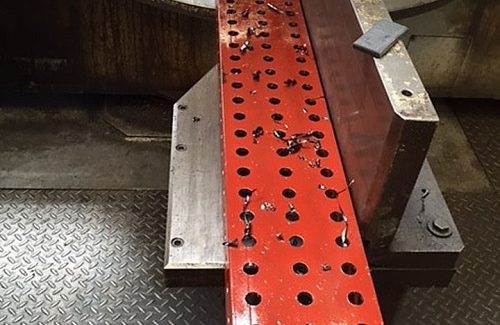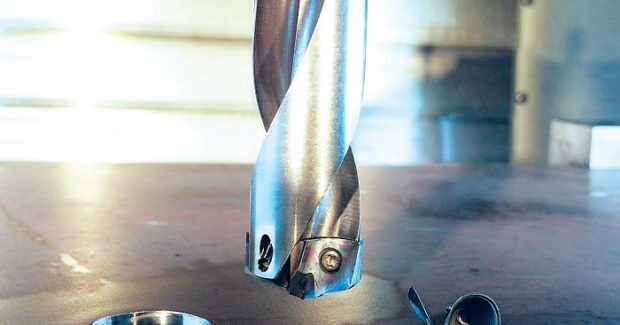Cutting Time for National Infrastructure
As the structural steel market looks for ways to make more parts in less time, some shops are finding a better way to manufacture steel beams with bolt holes.
Posted: August 17, 2018
Structural steel is a cost-effective framing material that brings great value to a construction project in terms of initial cost. It can also reduce other costs, including those associated with foundations and façade systems. With the $21.2 billion in new infrastructure dollars passed by Congress earlier this year, combined with a high level of private sector construction, a huge increase in demand for structural steel products has been generated. According to the American Institute of Steel Construction (AISC; Chicago, IL), U.S. steel mills have the capacity to produce 9 million tons of structural steel each year. While contractors are performing preliminary site preparation and foundation work, structural steel is fabricated offsite before being delivered and erected at the job location to accelerate each project schedule. This is a major advantage in meeting construction deadline demands, because the structural framing system is always on the critical path of the project regardless of material.
Upstream in this critical path are the fabrication shops, contract manufacturers, metal service centers and related component suppliers that invest in machinery to increase part production through higher efficiency, increased speeds and penetration rates. Many of these shops have made massive investments in machinery that can run carbide tooling to make more parts faster: by saving ten minutes per beam when producing ten beams per shift, the higher penetration rate of carbide tools means they can fabricate 11 beams in the same amount of time – some shops that once purchased 15 tons of steel per week have now increased to 17 tons per week, a 35 percent increase in production that is key to meeting construction schedules.
As the search continues for cutting tools that can make more parts in less time, finding the right tool for specific structural steel applications requires understanding how quite a bit of variance can exist in the chemical composition of material that is referred to as structural steel. Industry parlance sometimes refers to structural steel as material that is not “clean” due to the presence of a variety of potential ingredients. Material requirements are somewhat lenient: there tends to be a bit more leeway on how tightly the quality is held on the chemical composition than if it were to be used as a support for a rocket part. The driving factor is that structural steel has a lower carbon content that tends to make chips formed quite stringy. This material also does not machine very well. It is regarded as an entry level steel, not highly refined, lower in carbon content and perfectly fine for the types of loads it is typically designed to handle.
Many shops look for tools to improve on their older drill technology, which means the success of a new cutting tool must be measured by application: for one fabricator it might be the number of holes drilled, while another shop might be more interested in meeting a particular penetration rate, or having minimal exit burrs. The best approach for a cutting tool supplier is to gather the information on user requirements, place the proposed tool on the machine and test it by cutting actual production parts. They should understand the equipment the tool runs on and the factors that may affect tool performance and tool life. Recognizing the quirks of particular machines, knowing their pluses and minuses, allows toolmakers to take advantage of the machine’s capabilities based on different tool geometries, coating, substrates, speeds and feeds. New high penetration tools are being developed in response to the increased needs of the structural steel marketplace that can stand up to the machines, material, and environment commonly found in these operations.
For example, our Structural Steel GEN3SYS® XT drilling system is designed for machines that run higher penetration rates. One major steel fabricator that produces bolt holes in structural steel beams handles up to 80,000 tons of steel a year. Running 24/7 to process steel and steel tools to meet demand, they deliver about 500 to 600 tons of steel each day to customers using a HSS twist drill to make bolt holes, an old drilling technology with long cycle times that required regular regrinding and resetting. They wanted to upgrade and move away from twist drills toward something that could increase production while getting better chip formation, tool life, and hole tolerances. They embarked on an extensive testing program to compare their existing system with GEN3SYS XT high penetration carbide drills for structural steel cutting. They ran the new tips on their machinery alongside the old drills through every aspect of daily operations, comparing performance quality, ease of use, and speed.
These tests were organized specifically to avoid interrupting production. After two to three weeks of testing, they determined that the new drill tips were better than the old drills in almost every respect. The shop can now cut through steel significantly faster, with better chip control and less noise. Machine operators can use and change tools much easier than before, without the need to remove the holders from the spindles. We also perform regular onsite check-ups on their technology and provide specialized training to all employees working with our tooling. New drill tips are always stocked so they are never left in need of tooling. Our automated ordering systems, short lead times, and easy electronic invoicing work perfectly with their business procedures: they can order online and receive stock the next day.
Since this testing partnership worked so well, the steel fabricator decided to participate in a program of continuous testing where new drilling tools are brought in regularly. Operators run the new drills through basic operations to see if they stand up to the test. The shop constantly gains new performance information and testing data to improve their drilling technology. After testing, they send reports to detail how the drills performed in given steel applications. No part of the testing interferes with daily operations and the information goes towards providing even better tooling in the future.
Another steel fabrication shop drills I-beams made out of structural steel for construction sites. They drill 13/16 in holes that are ½ in deep. Their previous tooling had a cycle time of 9.29 seconds, a life of roughly 600 to 800 holes, and they were paying $138 per drill and regrinding five to six times – they needed to reduce cycle time, reduce costs, and alleviate problems with in-house tool regrinding. After switching to new drills, they eliminated the need for regrinding, decreased their cycle time to 5.56 seconds, and achieved a 37 percent total cost savings of $149.64 for every 1,100 holes they processed. Another shop machines structural plates from A36 steel. Their existing tool drilled a 1-1/16 in diameter through hole to a thickness of 1.25 in. The tool had a cost per hole of $0.573 and a tool life of 1,200 holes per insert. To reduce their cost per hole, they began using the GEN3SYS High Penetration Drilling System. The penetration rate increased by more than 39 percent, tool life increased by 8 percent, and cost per hole reduced to $0.355 – savings of over 38 percent.
https://youtu.be/wkyCCXN1Q6Q
Rob Brown is a product manager at Allied Machine & Engineering Corporation, 120 Deeds Drive, Dover, OH 44622, 330-343-4283, www.alliedmachine.com.
















